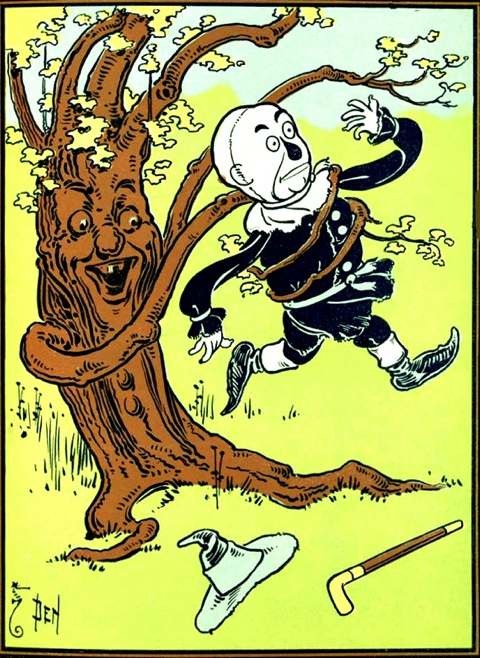
Part of this “candelabra” tree crown failed in a windstorm 
The proximity of this tree to a school makes it a high risk
I’ve been a gardening mythbuster for almost a quarter century. You’d think the quality of information would slowly be improving, given the increased sophistication of many gardeners regarding their information source. But every day my news feed connects me with articles that I’m sure some AI entity thinks will be enlightening. One recent story getting lots of eyeballs is entitled “The Benefits of Girdling a Tree Vs. Cutting It Down.” It makes for a good application of the CRAP analysis. While the link to the publication I’ve provided will go into more detail on CRAP analysis, all you need to know for this post is we’re going to assess Credibility, Relevance, Accuracy, and Purpose of the information.

First, let’s consider the Credibility of the source. According to HouseDigest.com, the author is “a plant mom…intrigued by nature and plant life which she exhibits by caring for and doting on her succulents.” Her college degree was in applied biochemistry, which has no substantial connection to applied plant and soil sciences. Bottom line, the author is not an expert in the science of tree care.

Let’s look at Accuracy next (we’ll get to relevance later). The author’s premise that girdling is “another great option” for tree management is grossly inaccurate. The article contains no links to any published research supporting her opinions, and demonstrates a lack of understanding woody plant physiology. The author states that girdling “would prevent erosion from occurring” in contrast to cutting the tree down which apparently removes “the tree roots acting as a protective cover for the soil.” Cutting a tree down removes its crown, but leaves the root system undisturbed. The roots stop transporting water aboveground (there’s no demand for it any longer) thought they can continue to grow as long as they have stored resources. Eventually they will die and their woody structure slowly decomposes.

Girdling the tree, on the other hand, does not prevent root uptake and transport of water through the xylem to the crown of the tree. It does prevent phloem movement of sugars and other resources from the crown to the roots. In other words, roots remain active in transporting water and nutrients but slowly starve to death without phloem-transported sugars and other resources. A good article on the topic of tree girdling goes into more physiological detail on the process that causes trees to decline “before entering an irreversible state of desiccation caused by definitive root death.”
Another possibility is that the girdled tree might send up new shoots below the girdling, leading to the formation of a new crown. Without constant vigilance in removing these new branches, the tree will survive and presumably continue to cause whatever problems that led to the original mismanagement.
The author also suggests that girdling is useful in preventing disease spread: “A sick tree would need to be killed in order to prevent the disease from spreading out to other trees and vegetation.” Or, if your trees “are hoarders by nature,” girdling renders them “incapable of taking in nutrients and being a burden to the environment.” Neither of these statements is accurate.

While the information in this article is somewhat Relevant to homeowners, it does wander into agricultural advice. We’re advised if we have “a danger tree or one that is resting on arable farmland with crops on it, it’s strongly advised that you chop it down and not girdle it. You don’t want an unpredictable girdled tree falling on your harvest, house, or worse — on someone — out of nowhere.”
At this point it’s worth noting that deliberately killing a tree by girdling also opens the property owner up to legal action should the tree fall and damage property or injure someone. This alone should be enough to dissuade property owners from taking advice from this article. And given the number of years it can take for a girdled tree to die (and eventually fall), is this really a useful process if you need to have a tree removed for some reason?
Finally, what is the Purpose of this article? It’s hard to know exactly why the author promotes girdling, and the language she uses in describing tree care is odd. Statements such as “sometimes circumstances call for trees to be put down and killed” and “trees need to be put down for all kinds of reasons” seem to equate trees with stray animals or dangerous wildlife. It creates an antagonistic situation where none exists.

Tree management, especially when it come to discussions about removal, needs to involve a certified arborist who can assess potential risks associated with leaving, as well as removing, any tree.












Thank you for this rebut….I saw the article and in that same day also one on the importance of adding pine cones for drainage to potted plants. They pissed me off, as does this who field of amateurs posting horticultural nincompoopery as an utterly illegitimate income source!
Thank you for your article. With luck the writer of the other article will see this and learn something!
Thanks for taking on this weirdly inaccurate and misleading article. The level of hogwash on the internet never ceases to amaze me. One thing to note: your link in the article to another resource, ostensibly on girdling, actually takes one to an article on “fire effects on tree physiology”. Tracy Neal
Yes, it’s on the girdling effect of fire. Different cause, same result.
House Digest articles lack any credibility , IMHO. Thanks for the reminder and the laughs–Internet access is both a blessing and a curse!
Hm. AI translation from the Chinese, perhaps? ‘Putting a tree down.’ What a gaffe.